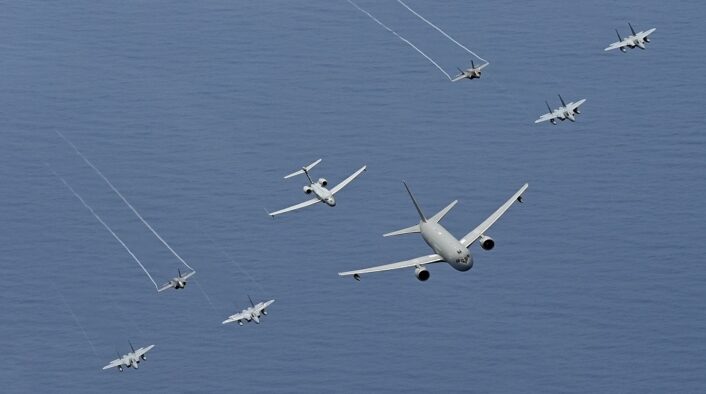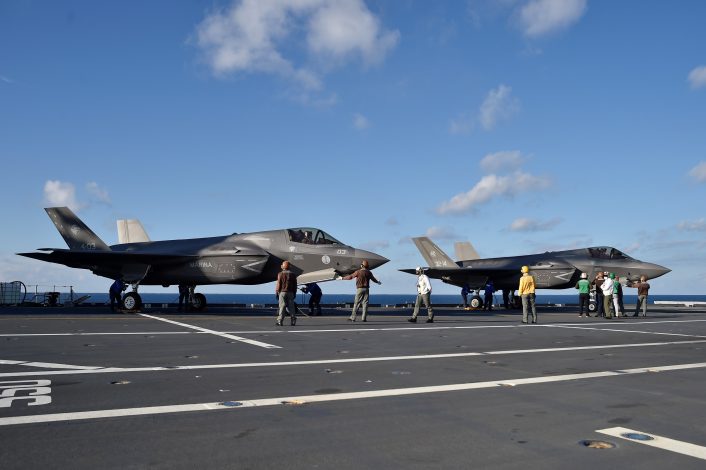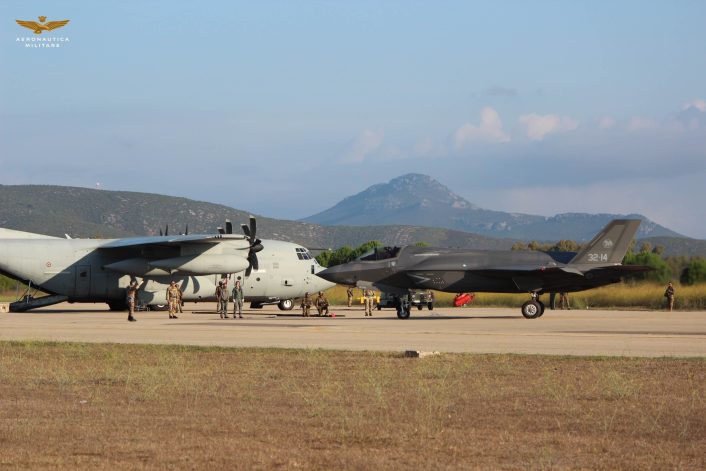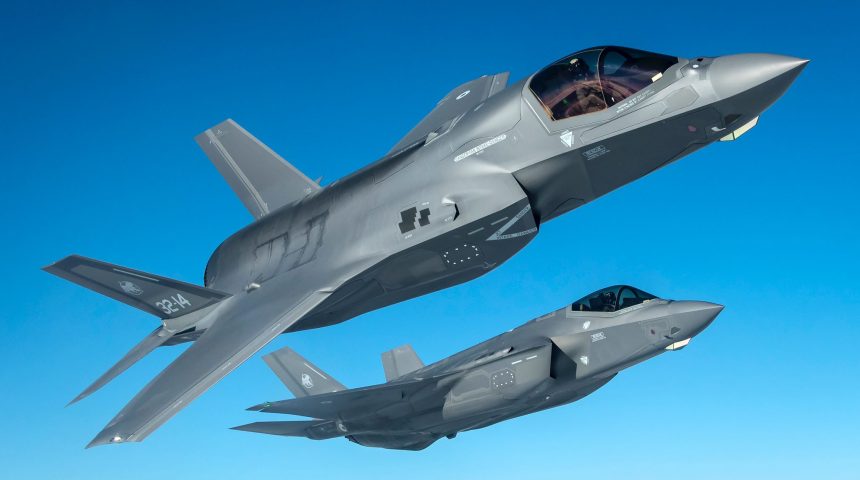Gen. Goretti discussed ItAF priorities with the Mitchell Institute, including F-35, GCAP, the Pacific theater and operational concepts.
Recently, the Mitchell Institute for Aerospace Studies hosted Gen. Luca Goretti, the Italian Air Force Chief of Staff, for a discussion about the service’s priorities in a range of topics, from the F-35 to power projection and new operational concepts and technologies. While speaking with Lt Gen Dave Deptula, USAF (Ret.), Gen. Goretti provided some interesting insights about the steps the service is taking to stay on top on its game and keep up the pace with the new technological advances and novel threats.
Asked about the benefits and opportunities of being the leading nation in Europe for flying both the F-35 and the MQ-9, Gen. Goretti stated that, like when the Predator entered service, the F-35 has brought many changes to the air force. “The F-35 has to be considered not only an aircraft, but it has to be considered a node of data information,” said Goretti. “So we used that aircraft to change completely the mindset of the people. It is no longer an aircraft to fly but actually is a data machine available in the air for everyone.”
Italy is the nation, after US and UK, that contributed the most to the F-35’s development and is now set to be a major player also in the next generation fighter development, as a partner with the United Kingdom and Japan in the Global Combat Air Programme. Similarly to the F-35, Italy has already started planning something very unique to exploit this great opportunity for expanding the vision and proficiency, both for the military and the industry, with a program that is set to be a turnout point for the future.

“GCAP has no more to be considered as an aircraft. It is a system of systems, where everybody can play and use the technology and digital information, artificial intelligence, or other means in order to be relevant for the fight of the future,” said Goretti. “With this in mind, the program is not only a way to increase our knowledge on the technical point of view, but also how to increase the knowledge and the power of the people that will fly those kinds of systems.”

This is already influencing the training of the personnel, starting from the Academy and pilot training. When putting GCAP in relation with other next generation programs, either aircraft, satellites, command assets, the key word is interoperability, as Gen. Goretti says the risk of losing time must be reduced because, if the need arise, there could not be time to think about how to make all these assets operate together efficiently.
This led the discussion towards another important recent topic, the Combined Joint All Domain Command and Control, emphasizing the need to integrate with allies and partners. Gen. Goretti states that there are not many problems related to the integration itself, although the trust between allies and partners is a key factor that can reduce future problems. On the other hand, the Ukrainian war brought up new issues to the table and reducing frictions to share information is vital.
“Information sharing is a very important tool, not only in the future but even today. We can’t afford to wait in order to see information,” said Gen. Goretti. “If we have to cooperate all together, we need to have the common view of what’s going on, especially coming from equipment capable to bright the light inside the tunnel for every one that is not capable to see inside the tunnel.”
Intelligence, Surveillance and Reconnaissance is another big topic, with the demand for that kind of information arising in every operational theater and air forces around the world seeking to modernize these capabilities. Gen. Goretti says that ISR, now more than ever, is a real player of the modern fights and it cannot be afforded to not have ISR platform available every time, as they are the first one to be in the air for every operation.
The Italian Air Force is committed on this, working in recent years to improve these new capabilities. A very close cooperation has been established with the U.S. Air Force to acquire platforms, which Goretti defined as “fifth generation ISR platforms”, that can be relevant in today’s world. The program is proceeding smoothly and the cooperation is helping to increase knowledge and proficiency of the personnel that will operate these systems.
The discussion then moved to power projection, talking about the recent deployment of Italian F-35s, along with airborne early warning, air refueling and rescue assets, to Japan. Gen. Goretti said the ItAF wanted to prove its ability to project air power anywhere in the world and Japan was chosen because of the excellent relations between the two air forces. At the same time, this allowed to test the ability to sustain this deployment without impacting any of the activities already planned and in place in Europe.
“With the geopolitical situation like this today, we cannot afford just to be caught by surprise, just in case one day we have to do something in the Indo-Pacific,” Goretti said. “I cannot afford just to receive an order to deploy somewhere and not be able to move around because of diplomatic clearances, for instance, because I cannot do stops or overflight somewhere.”

Building up on this, Gen. Goretti said next year the ItAF will deploy almost 25 jets to Australia for exercise Pitch Black, including Eurofighter F-2000s, F-35As and F-35Bs in cooperation with the Italian Navy. In fact, thanks to the increased cooperation with the navy, the F-35Bs of both services will fly together from the ITS Cavour aircraft carrier to take part in the exercise. This will also be an occasion to check the issues and the preparation required to fly non-stop from Europe to the Indo-Pacific if necessary.
The service is not only evaluating its capability to project air power, but also the capability to host and sustain aircraft. The recent NATO Tiger Meet was an important test, with Gioia del Colle hosting 80 aircraft for two weeks. The ItAF is also building an air expeditionary capability, pretty much in line with the U. S. Air Force’s Agile Combat Employment, around the F-35B.
“We do have many, many short airfields around the world. So we decided, why don’t we take some Bs for short-distance takeoff and landing in order just to be relevant everywhere in the world,” Goretti said. “The Afghanistan scenario gave us a thought on this. So we decided just to get some Bs. And then it turned out to be a wise idea, because if you consider also what’s happening in Ukraine, airfield dispersion can be maybe one day the only way to protect your high-value assets.”
This will allow to be more agile and move aircraft away from the main operating bases and fly and fight from deployed locations. Work is still being done to further expand this concept, both by training and developing new capabilities and procedures. An example of that are the periodic expeditionary training events with F-35Bs deploying to austere locations, refuel with the ALARP system, rearm and launch again, without having support or infrastructure in place other then the one on the supporting C-130.
“We decided just to ask to our logistic people to find standard buildings and similar structures to build in several airfields in our country, and proposing the same thing also to other friendly countries, in order just to have the same buildings, the same equipment, the same block in the same spot, in case you do have to run away from your main operating bases,” Goretti said. “We cannot afford to lose time. But most of all, we cannot afford to lose our capacity, only because we haven’t planned accordingly in advance a place to run and protect ourselves.”
One of the keys to do this and be able to move quickly at a moment’s notice is to pre-position in advance everything needed to disperse aircraft, as nothing can be built from scratch in one day, added Gen. Goretti. As he mentioned later, the same applies also to the stockpiles that need to be replenished after donating many weapons and munitions to Ukraine. In fact, this is a lengthy process that could take years because many nations use the same equipment and a sudden situation, like recently happened in Israel, could cause nations to find themselves without what they need to fight.









